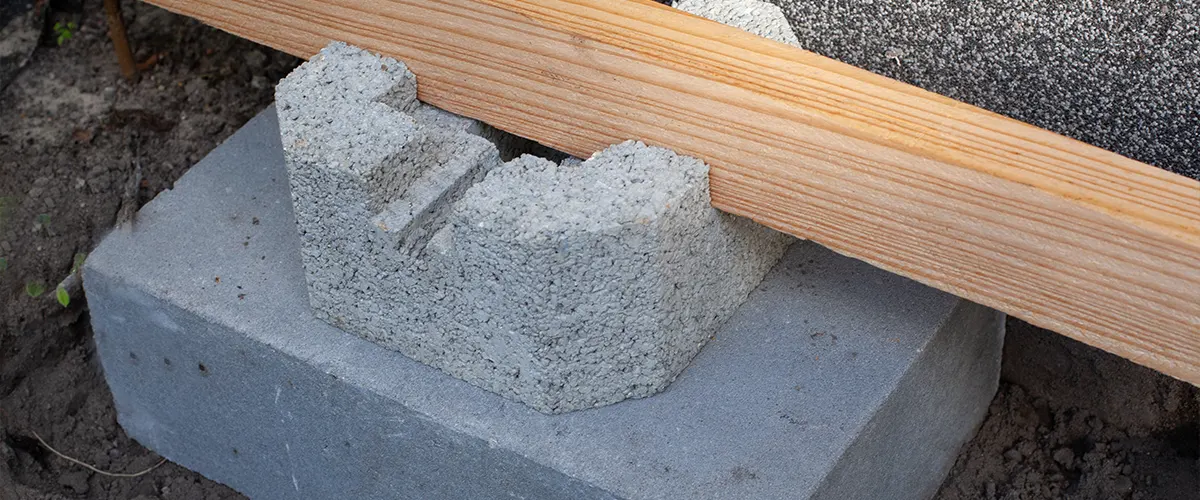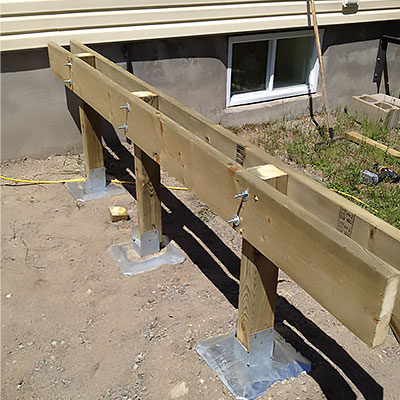Make Certain Stability and Durability With Properly Set Up Deck Grounds
Deck footings may not be one of the most glamorous element of deck construction, however they play an essential duty in guaranteeing stability and durability. Effectively installed grounds give a solid foundation for your deck, protecting against common problems like drooping, changing, and even collapse. Choosing the ideal kind of ground and correctly installing it can be a complex process. In this discussion, we will certainly discover the importance of proper deck footings, elements to think about throughout installment, various kinds of footings offered, detailed installation guide, and maintenance ideas for making sure durable grounds. So, if you intend to ensure the stability and longevity of your deck, maintain reading to discover the key insights to achieve a structurally sound and durable outdoor space.

Significance of Appropriate Deck Grounds
Why are properly installed deck footings important for the security and long life of your deck? The solution depends on the basic duty that deck grounds play in supporting the weight of the entire structure. Deck footings are the foundation on which the deck rests, transferring the load from the deck to the ground. It can lead to a range of issues that compromise the security and long life of the deck. when footings are not correctly installed.
Firstly, effectively mounted deck grounds disperse the weight of the deck uniformly, avoiding any type of uneven settling or sinking. This is particularly important in areas with unsteady soil, as it aids to mitigate the threat of the deck breaking down or shifting. In addition, well-installed grounds make sure that the deck stays level, preventing any kind of structural damage that can take place when a deck ends up being uneven.
Second of all, effectively set up grounds supply a solid support for the deck, stopping excessive activity and sway. This aids to preserve the structural honesty of the deck, decreasing the risk of injuries or mishaps. It additionally lessens the damage on the deck, enabling it to stand up to the elements and regular usage for a longer amount of time.
Factors to Think About for Deck Footing Installation
When installing deck footings, there are a number of crucial elements to consider for proper installment. Different soil kinds have various load-bearing capacities, so it is essential to conduct a dirt test to guarantee the grounds can sustain the weight of the deck and its residents. By taking into account these aspects, you can make sure the proper installment of deck footings and enjoy a lasting and secure deck.
Kinds Of Deck Footings to Pick From
There are a number of different sorts of deck footings readily available for you to select from. Each kind has its own benefits and negative aspects, so it's vital to consider your specific demands and the conditions of your deck prior to making a decision.
One usual kind of deck footing is the concrete ground. This includes digging openings in the ground and putting concrete into them to develop a strong foundation. Concrete footings are sturdy and give exceptional security, making them ideal for decks in locations with challenging dirt conditions or high wind loads.
An additional choice is the helical pier footing, which is composed of a steel shaft with helical plates that are screwed right into the ground. These footings fast to install and can be made use of in different soil kinds, including sandy or clay dirts. They are likewise adjustable, permitting for easy progressing of the deck.
Sonotube footings are another preferred option. These grounds are produced by placing a cardboard tube in an opening and filling it with concrete. Sonotube grounds are relatively very easy to install and give sufficient stability for smaller sized decks or in areas with much less requiring soil problems.

When choosing the kind of deck ground, it's critical to take into consideration factors such as dirt problems, deck dimension and weight, regional building ordinance, and personal choices. By picking the proper ground type, you can guarantee the stability and longevity of your deck.
Step-by-Step Guide for Putting Up Deck Footings

Determine the place: Start by noting the exact setting of each ground using stakes and string (Deck Footings). Take into account any kind of local building regulations or policies pertaining to setback distances
Dig the holes: Use an article opening miner or an auger to dig the openings for the grounds. Generally, a depth of at least 36 inches is recommended for stability.
Level the holes: Make sure that all-time lows of the openings are degree (Deck Footings). This can be attained by making use of a degree or a straight board throughout the top of the openings
Include additional reading crushed rock: Area a layer of crushed rock at the end of each opening to improve drainage and prevent the footing from sinking into the soil over time.
Insert the footing forms: Insert the footing forms into the openings, guaranteeing they are centered and level. Use stakes to safeguard them in area.
Mix and pour concrete: Follow the directions on the concrete mix bag to prepare the concrete. Pour the concrete into the footing types, loading them entirely.
Smooth the surface area: Utilize a trowel to smooth the surface of the concrete and remove any kind of air pockets. Permit the concrete to treat according to the producer's instructions.
Maintenance Tips for Durable Deck Grounds
Correct maintenance is vital for guaranteeing the long life and stability of deck grounds. By regularly examining and keeping your deck footings, you can stop damages and prospective safety risks.
Routine cleaning is likewise vital for preserving deck grounds. Plant life, dirt, and particles can collect around the grounds, which can cause moisture accumulation and degeneration. Cleansing the grounds frequently, making use of a brush or a pressure washer, can assist stop these concerns and expand the lifespan of your deck.
In addition to cleaning, it is essential to keep the area around the footings free from any obstructions. Prevent stacking products against the footings or enabling plants to grow as well near to them. These obstructions can trap wetness Recommended Site and trigger the footings to weaken with time.
Lastly, regular resealing of the grounds is advised to shield them from dampness and various other ecological variables. Using a water-proof sealer can assist avoid water damage and extend the life-span of the footings.
Conclusion
To conclude, proper installment of deck grounds is vital for making certain security and durability of your deck. Elements such as soil kind, tons capability, and local building regulations need to be considered when picking the ideal kind of deck footings. Adhering to a detailed guide for installment and normal maintenance will aid to make sure the footings continue to be durable and long lasting.
In this discussion, we will certainly check out the importance of correct deck footings, variables to take into consideration during installment, various types of grounds available, step-by-step installment guide, and upkeep suggestions for ensuring resilient footings. Deck grounds are the foundation on which the deck relaxes, transferring the tons from the deck to the ground.One common type of deck reference ground is the concrete footing. Put the ground types: Put the footing creates into the openings, ensuring they are centered and degree.In conclusion, correct installation of deck grounds is essential for making certain stability and durability of your deck.